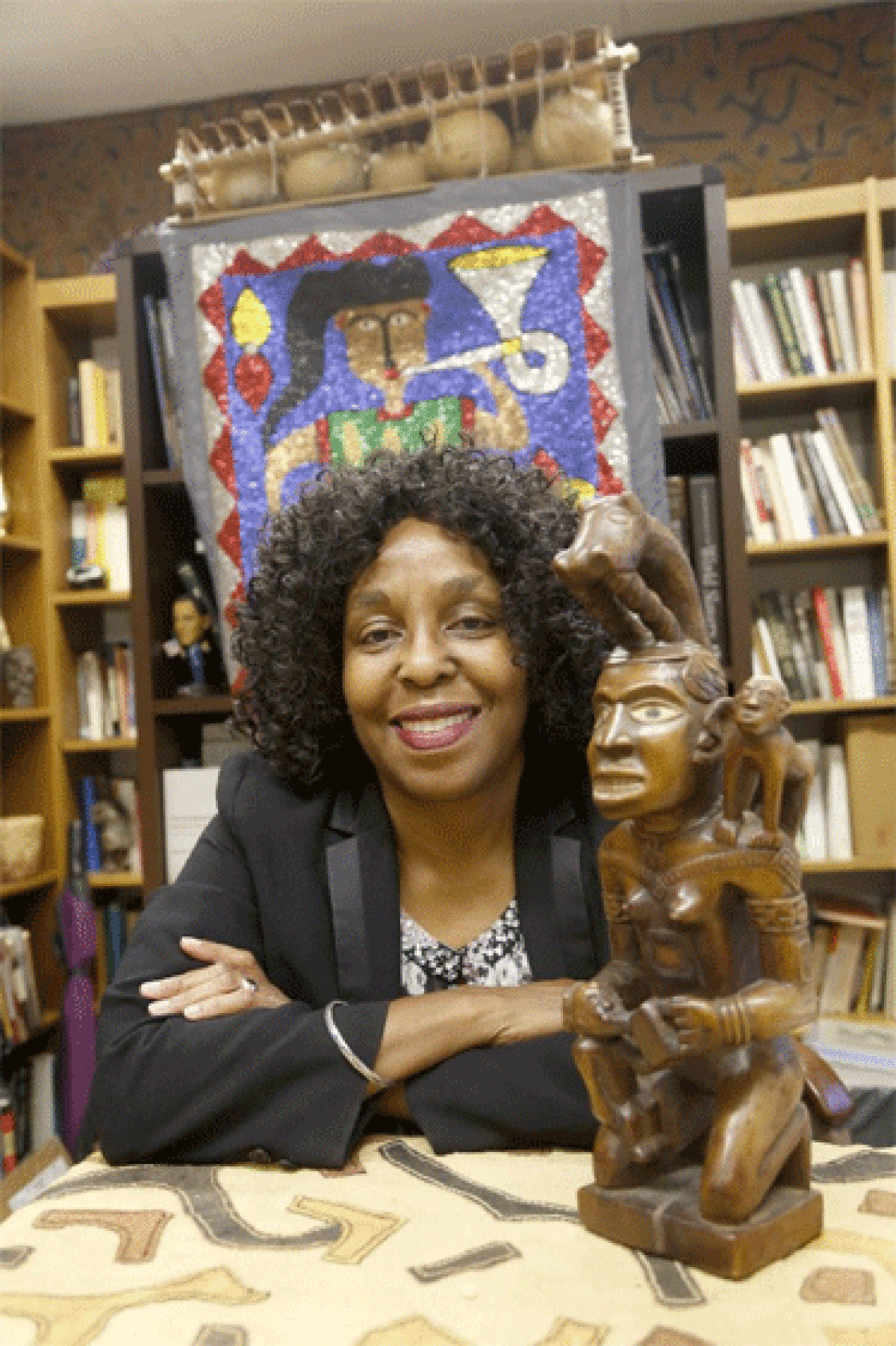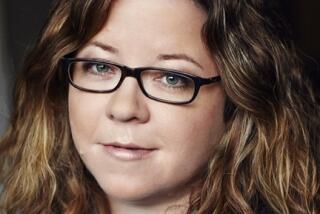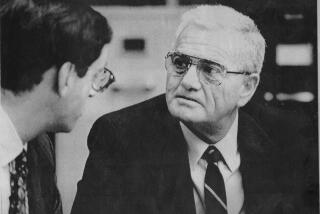Brenda E. Stevenson, writer of wrongs

Historian Brenda E. Stevenson (pictured in her UCLA office, with an African sculpture) mostly writes about the long-gone â 18th and 19th century African Americans, and the lives of enslaved women. Then came the case that made history while L.A. watched: Korean-born shopkeeper Soon Ja Du killed black teenager Latasha Harlins over a bottle of orange juice. A jury convicted Du of voluntary manslaughter, but she was sentenced only to probation and community service.
Stevensonâs new book, âThe Contested Murder of Latasha Harlins,â analyzes the other âno justice, no peaceâ case that echoes through the 1992 riots and into the present day.
Thirteen days after the Rodney King beating, Harlins was shot and killed. Where were you when all of this happened?
I had just moved to Los Angeles. Iâd been teaching at the University of Texas at Austin, and I thought, âL.A. is going to be this wonderful, liberal place.â The Rodney King event happened, then Latasha Harlins. I thought Iâd jumped from the frying pan into the fire.
How does the Harlins case conflate with the Trayvon Martin case?
You have the [shootersâ] assumption of a deadly threat. Soon Ja Du testified that she thought Latasha Harlins had a gun in her backpack; thatâs why she came out with the gun herself. George Zimmerman said, âI thought he was going to kill me.â
The defense attorneys used almost the same terms in describing Latasha Harlins and Trayvon Martin. Latasha Harlins was not a gang member, she did not have a weapon in her bag, she did have the money [to pay for the juice] in her hand. Trayvon Martin did not have a weapon, he had iced tea and Skittles. I think itâs similar, and the community has responded with a sense of injustice in both cases.
And women are very important â all six jurors [in the Martin case], the judge, his friend who was on the phone. [In the Harlins case], the defendant, the victim, the judge, the prosecutor. Women play important roles in the cases as well as the way the larger society has looked at the cases.
Weâve seen both L.A. crimes on videotape, but hasnât Kingâs case eclipsed Harlinsâ in historical memory?
Not on the street and in the community, I donât think. But [the King case] was about men. The typical racialized dynamic is the black male and the white aggressor â this was the notorious LAPD being racist again. We saw it in Trayvon Martin.
People were not used to thinking about women in this way. The president just [spoke] about racial profiling â he never mentioned females once. Of course, he was talking about his experience, but he has two daughters.
When people [in the black community here] talk to me about the L.A. riots, they say itâs about Rodney King but also about Latasha Harlins. At Eso Won bookstore last year, I asked the owner: âDo you have the new Rodney King book?â and he said, âYes, but as far as Iâm concerned, the riots were more about Latasha Harlins than Rodney King.â He said: âShe shoots a girl in the back of the head, the jury finds her guilty and she walks free.â
Latasha Harlins did not survive the gunshot. At least Rodney King was alive. He could tell his story. But a 15-year-old girl had been killed. Latasha Harlinsâ name is part of South Central lore. Tupac Shakur has three songs in which her name is mentioned.
People will grab my arm and say, âDo you remember Baby?â They always make the comparison. This man was sentenced [to a month in jail] for beating his dog [Baby]. People are disgusted by the notion that someone would go to jail for hurting an animal but not a person.
Your book looks at the dynamic among the three women in the Harlins case: judge, victim and defendant.
If you look at the histories of the three â Jewish, African American and Asian American â at some point their families would have crossed paths in terms of their [economic, immigrant] experiences. But itâs clear in Judge Joyce Karlinâs sentencing that her experiences resonated not with Latasha Harlins and her family. Her family had been shopkeepers too, [like Du].
Young female African Americans in working poor families are often regarded just as young black males â as violent, as not being able to contribute to society. Soon Ja Du testified she thought Latasha Harlins was in a gang because her son had explained that gang members wore the kind of clothes Latasha Harlins had on. And [Du] said: âShe hit me with that iron fist. I thought, âSheâs going to kill me.ââ
Judge Karlinâs sentencing statement [spoke of] Du as being a good mother, being a good wife, thatâs why she was in the store that day. She believed that Soon Ja Du was the victim, this feminized victim.
Latasha Harlinsâ gender sort of disappears. Her class and race really did paint the portrait of a violent South Central youth attacking an older, small, fragile woman.
Did you talk to Joyce Karlin or Soon Ja Du or the prosecutor, Roxane Carvajal?
I spoke with Carvajal on the phone several times, but she refused to give an interview. Judge Karlin â we tried to get an interview with her and could not. Soon Ja Du said she would give an interview, then someone in her family picked up the phone and said she would not.
If you could interview them now, what would you ask?
I would ask Karlin: âWhat did you think the community or society would think of not giving Du any jail time? Did you have a clue it would affect your career as much as it did?â [Karlin was the subject of a failed recall. Her sentence was upheld becase of judgesâ broad sentencing discretion.] At some level [the sentence] had to be inexperience. [It was Karlinâs first jury trial.]
I would ask Soon Ja Du, wasnât she really just very angry? Given the hardship of her family, her not wanting to own the stores, her being uncomfortable around the clientele, feeling her son had been victimized by gang members â I felt she approached Latasha Harlins with a great deal of anger. Itâs like, âIâm not taking anything else off these people.â
What do you want people to take away from your book?
I want people to think more about women and their role, particularly in the criminal justice system â women as victims but also as perpetrators and as lawyers, judges, juries. I want people to think about the black female and her troubled place in the justice system as well.
Did working on the book change you?
It did. I never thought of myself as doing anything outside the 19th century. It really pulled me into Western history, into looking at women from other ethnic and racial groups. It got me really interested in the court system.
Your daughter is 18. How has this case affected what you tell her?
Iâm very careful about my daughter, where she goes, what she wears, the size of the purse she takes. Whenever she goes into a store, I insist that she take a tiny purse or I will hold her purse for her if we are together because I donât want her to be accused of shoplifting. She knows Iâm overprotective in this way, but it happens too often. My daughter sometimes says, âThis is really unfair,â and I say, âYes, it is unfair, but stay safe first.â
Follow Patt Morrison on Twitter @pattmlatimes
This interview was edited and excerpted from a taped transcript. An archive of Morrisonâs interviews can be found at latimes.com/pattasks.
More to Read
A cure for the common opinion
Get thought-provoking perspectives with our weekly newsletter.
You may occasionally receive promotional content from the Los Angeles Times.











